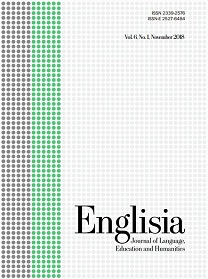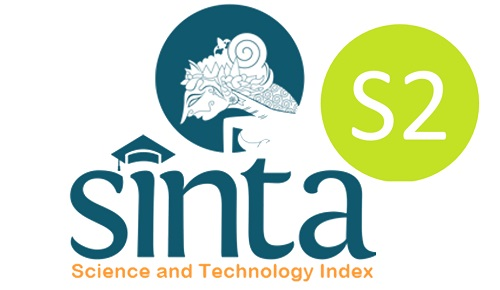English Medium Instruction (EMI) practice: Higher education internationalization in Indonesia
DOI:
https://doi.org/10.22373/ej.v8i2.8961Keywords:
English medium instruction (EMI), ESP, internationalisation, higher educationAbstract
Indonesian universities are striving to obtain international recognition in this global competition of higher education. In doing so, many offer English Medium Instruction (EMI) courses. However, there is no documentation of the arrangement of EMI practice in Indonesian universities. This article presents a picture of the current implementation of EMI in some universities as one strategy to obtain international recognition. Survey research is selected to gather some key issues surrounding the implementation of EMI. A questionnaire is administered to 30 universities, and half of them returned the responses. Data analysis uses a descriptive approach. Findings show that the main reason for EMI practice in most Indonesian universities is to address current competition among global universities. Higher education internationalization is indicated in using the English language in two main types of EMI classes: 'Bilingual Class' and 'International Class'. This study also highlights the limited understanding of EMI practice implications in Indonesian universities, especially regarding relevant support given to both EMI students and lecturers. Some key suggestions from the research include incorporating English for Specific Purposes (ESP) in EMI programs and the importance of stimulating collaboration between both content and English lecturers.
Downloads
References
Aguilar, M. (2015). Engineering lecturers’ views on CLIL and EMI. International Journal of Bilingual Education and Bilingualism, 20(6), 1-14
Aizawa, I., & Rose, H. (2019). An analysis of Japan’s English as medium of instruction initiatives within higher education: the gap between meso-level policy and micro-level practice. Higher Education, 77(6), 1125–1142. https://doi.org/10.1007/s10734-018-0323-5
Briggs, J. G., Dearden, J., & Macaro, E. (2018). English medium instruction: Comparing teacher beliefs in secondary and tertiary education. Studies in Second Language Learning and Teaching, 8(3), 673-696
Chen, H., Han, J., & Wright, D. (2020). An investigation of lecturers’ teaching through English medium of instruction: A case of higher education in China. Sustainability, 12(10), 1-16. DOI:10.3390/su12104046
Dearden, J. (2015). English as a medium of instruction–a growing global phenomenon. Retrieved from https://www.britishcouncil.org/education/ihe/knowledge-centre/english-language-higher-education/report-englishmediuminstruction
Dewi, A. (2017). English as a medium of instruction in Indonesian higher education: A study of lecturers’ perceptions. In B. Fenton-Smith, H. Pamela, & W. Ian (Eds.), English medium instruction in higher education in Asia-Pacific: From policy to pedagogy (pp. 241-258). Switzerland: Springer
Doiz, A., Lasagabaster, D., & Sierra, J. M. (2013). English-medium instruction at universities: Global challenges. USA: Multilingual Matters
Dudley-Evans, T., & St. John, A., M. (1998). Developments in English for Specific Purposes: A multi-disciplinary approach. Cambridge: Cambridge University Press
Floris, F. D. (2014). Learning subject matter through English as the medium of instruction: Students’ and teachers’ perspectives. Asian Englishes, 16(1), 47-59
Galloway, N., Numajiri, T., & Rees, N. (2020). The ‘internationalisation’, or ‘Englishisation’, of higher education in East Asia. Higher Education, 80(3), 395–414. https://doi.org/10.1007/s10734-019-00486-1
Galloway, N, Ruegg, R. (2020). Supporting students to study through the medium of English: A comparative study of language and academic skills support in EMI programmes in Japan and China. Journal of English for Academic Purposes, 45. https://doi.org/10.1016/j.jeap.2020.100846
Hu, G. (2019). English-Medium Instruction in higher education: Lessons from China. The Journal of Asia TEFL. 16(1): 1-11. DOI: http://dx.doi.org/10.18823/asiatefl.2019.16.1.1.1
Huang, D.-F. (2015). Exploring and assessing effectiveness of English medium instruction courses: The students’ perspectives. Procedia - Social and Behavioral Sciences, 173, 71–78. https://doi.org/https://doi.org/10.1016/j.sbspro.2015.02.033
Hutchinson, T., & Waters, A. (1987). English for Specific Purposes: A learning centred approach. Cambridge University Press
Islam, M. M. (2013). English medium instruction in the private universities in Bangladesh. Indonesian Journal of Applied Linguistics, 3 (1), 126-137
Loeb, S., Dynarski, S. M., McFarland, D. A., Morris, P., Reardon, S., & Reber, S. J. (2017). Descriptive analysis in education: A guide for researchers. NCEE 2017-4023. National Center for Education Evaluation and Regional Assistance.
Macaro, E. (2015). English medium instruction: Time to start asking some difficult questions. Modern English Teacher, 24(2), 4-7. https://www.modernenglishteacher.com/media/5377/macaro.pdf
Macaro, E., Akincioglu, M, Dearden, J. (2016). English medium instruction in universities: A collaborative experiment in Turkey. Studies in English Language Teaching, 4(1), 51-76. www.scholink.org/ojs/index.php/selt
Macaro, E, Curle, S, Pun, J, An, J, Dearden, J. (2018) A systematics review of English medium instruction in higher education. Language Teaching. 51(1): 36-76. DOI: https://doi.org/10.1017/S0261444817000350
Nasir, M. (2015, November 30). Bilingual curriculum to be compulsory in universities starting from 2016. The Jakarta Post. Retrieved from http://m.thejakartapost.com/news/2015/11/30/bilingual-curriculum-becompulsory-universities-starting-2016.html
Simbolon, N. E, Oliver, R. & Mercieca, P. (2020). Lecturers’ perceptions of English medium instruction (EMI) practice at a university in Indonesia. Journal of Social Science and Humanities (JSSH), 28 (2),1065-1083
Simbolon, N. E. (2017). Partial English instruction in English medium instruction (EMI) practice: Perspectives from Lecturers in a University in Indonesia. J. Valcke & R. Wilkinson. (Eds.), Integrating content and language in higher education: Perspectives on professional practice (pp167-185). Frankfurt: Peter Lang
Vu, N. T. T., & Burns, A. (2014). English as a medium of instruction: Challenges for Vietnamese tertiary lecturers. The Journal of ASIA TEFL, 11(3), 1-31
Wachter, B., & F. Maiworm, F. (2014). English-taught Programmes in European Higher Education. The State of Play in 2014. ACA Papers on International Cooperation in Education. Bonn: Lemmens
Weinberg, L, & Symon, M. (2017). Crossing borders: The challenges and the benefits of a collaborative approach to course development involving content and language specialists in different countries. In: J. Valcke & R. Wilkinson. (Eds.), Integrating content and language in higher education: Perspectives on professional practice (pp. 135-150). Frankfurt: Peter Lang.
Downloads
Published
Issue
Section
License
Proposed Policy for Journals That Offer Open Access
Authors who publish with Englisia journal agree to the following terms:
- Authors retain copyright and grant the journal right of first publication with the work simultaneously licensed under a Creative Commons Attribution License that allows others to share the work with an acknowledgement of the work's authorship and initial publication in this journal.
- Authors are able to enter into separate, additional contractual arrangements for the non-exclusive distribution of the journal's published version of the work (e.g., post it to an institutional repository or publish it in a book), with an acknowledgement of its initial publication in this journal.
- Authors are permitted and encouraged to post their work online (e.g., in institutional repositories or on their website) prior to and during the submission process, as it can lead to productive exchanges, as well as earlier and greater citation of published work (See The Effect of Open Access).









